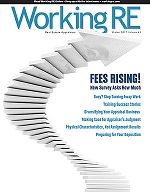 |
>> See Past News Editions >> Click to Print >> RE Agent / Broker E&O Insurance >> Am I a Working RE Subscriber? |
Three Dangerous Ways to Choose Comps
by Ryan Lundquist
It’s easy for an appraiser to get into value trouble when choosing comps and today I want to highlight three ways to do that. I’ve observed each of these methods very recently.
Price
When putting a value on something, searching by price is a quick way to NOT see the full picture. For instance, if we pull comps for a $750,000 sale by looking at all sales between $725,000 and $775,000, what we end up getting is a limited view of one price range. Have we truly found any similar properties or just the ones that have sold in that range and happen to support the contract price?
The danger of searching by price is that we can end up letting a few high sales impose a value on a property instead of letting similar homes paint a picture of value. This is why sometimes appraisers disregard the “comps” they are given from the real estate community because they are only similar in price rather than square footage, age, condition, location, upgrades, etc. If you are in the habit of searching by price in MLS when pulling comps, I might recommend searching by square footage instead (or by a parameter you think will help you make quality comparisons).
Capitalization Rates
The 2-4 unit market has been heating up in the Sacramento area where I live and work. In fact, the new Yardi Matrix 2017 Winter Report says multi-family rents in Sacramento will grow by 9.6% this year. If that’s how things shake out, we’ll basically have seen a 30% increase in rent over the past few years. Wow!! Anyway, I’m finding news that the hot rental market is causing some 2-4 unit properties to be priced according to unrealistic cap rates instead of realistic comps and rental income (or even realistic cap rates). What I mean is that sometimes comments in MLS say “check out the 8% cap rate” when the neighborhood really isn’t getting rates that low. Maybe surrounding properties are showing rates closer to 9-10%. This might not seem like a big deal, but when we plug an 8% rate into the cap rate formula instead of a realistic 9-10% rate, the value can be substantially different. My advice is to be cautious about imposing a cap rate on a property.
(story continues below)
(story continues)
Price Per Square Foot
In real estate it’s easy to see a sale down the street and then apply the price per sq. ft. from the sale to the subject property. But what if the price per sq. ft. doesn’t make any sense for the subject? The truth is that smaller homes tend to have a much higher price per sq. ft. than larger ones, and dissimilar homes might actually have a far different price per sq. ft. too. Thus my advice is to be cautious about imposing a certain price per sq. ft. on a property when searching for comps. Let’s pay attention to price per sq. ft. figures but at some point we have to ask the question, what are similar properties actually selling for? By the way, if you haven’t seen my Starbucks cups analogy, it’s a fun way to think about price per sq. ft.
Summary
All of these methodologies essentially help impose a value on a property because we end up applying a metric or price range to comp selection instead of looking for what is truly similar. Thankfully there isn’t only one way to search for comps but no matter what we do it’s important to try to be objective and discover value rather than doing something that might impose value on a property. By the way, here is how I tend to choose comps as an appraiser just in case you’re peeved I only told you what not to do.
About the Author
Ryan Lundquist is a certified appraiser and focuses on residential appraisals in the Sacramento area. His clients include home owners, real estate agents, governmental agencies, attorneys, and lenders. Lundquist runs the SacramentoAppraisalBlog.com, a top-ranking appraisal blog in the United States. He won the Affiliate of the Year award in 2014 from the Sacramento Association of Realtors. He is also the Chair of the Housing Opportunity Committee with the Sacramento Association of Realtors and a board member of the Real Estate Appraisers Association of Sacramento.
About Working RE
Working RE is a national publication serving real estate agents and brokers, appraisers and home inspectors. WRE is published by the Organization of Real Estate Professionals (OREP), providing E&O insurance to real estate agents/brokers, appraisers and home inspectors for over 15 years.
We’re always listening: Send your story submission/idea to the Editor: isaac@orep.org


